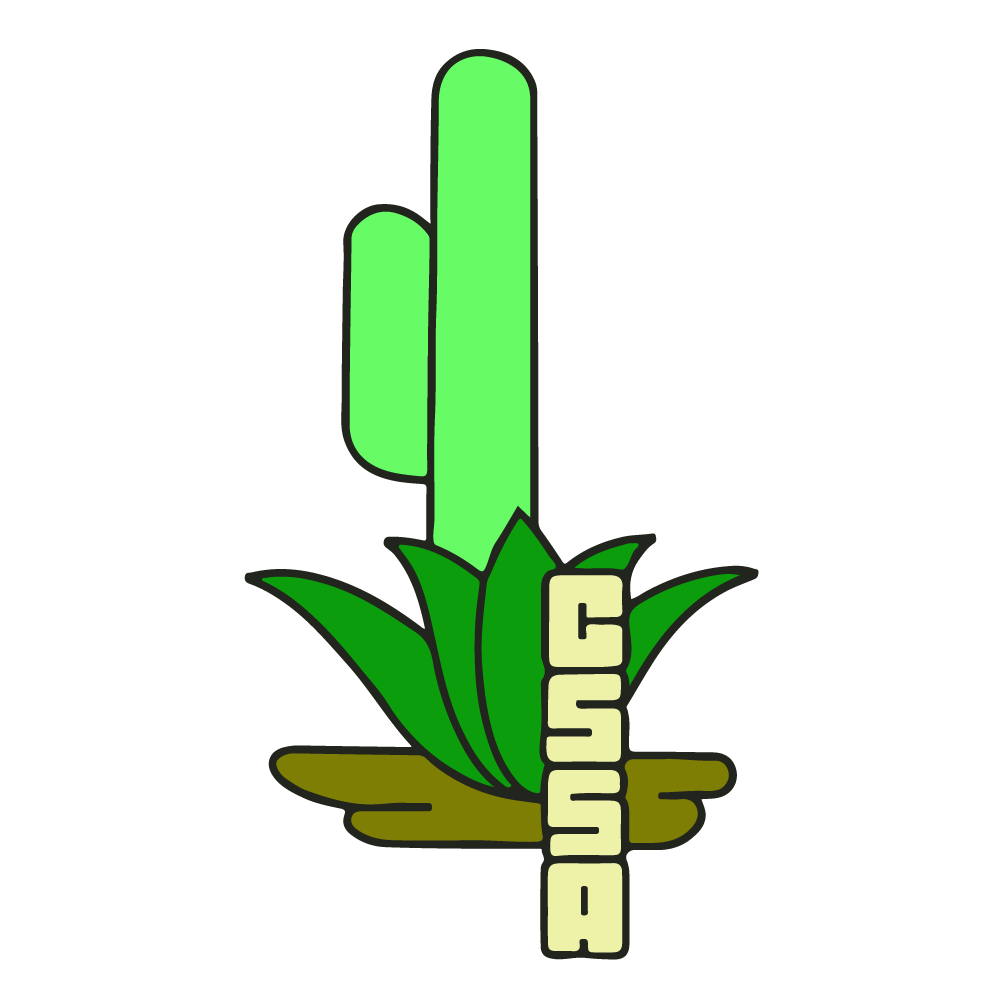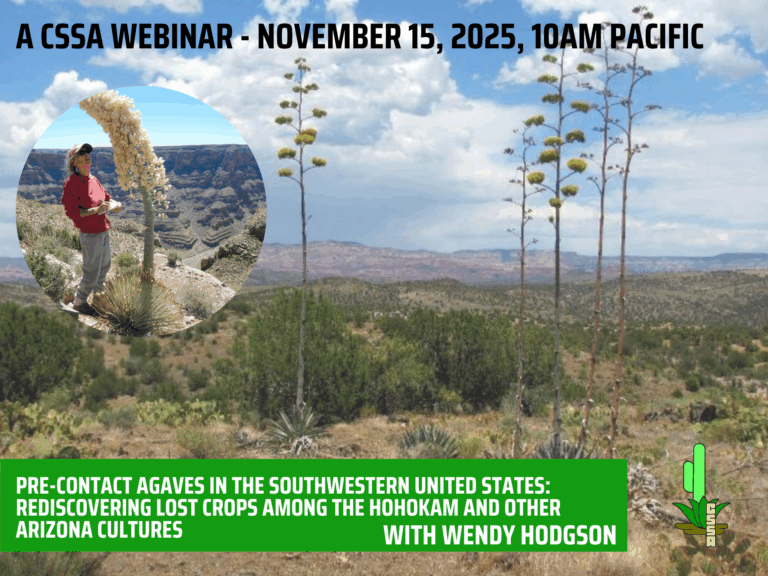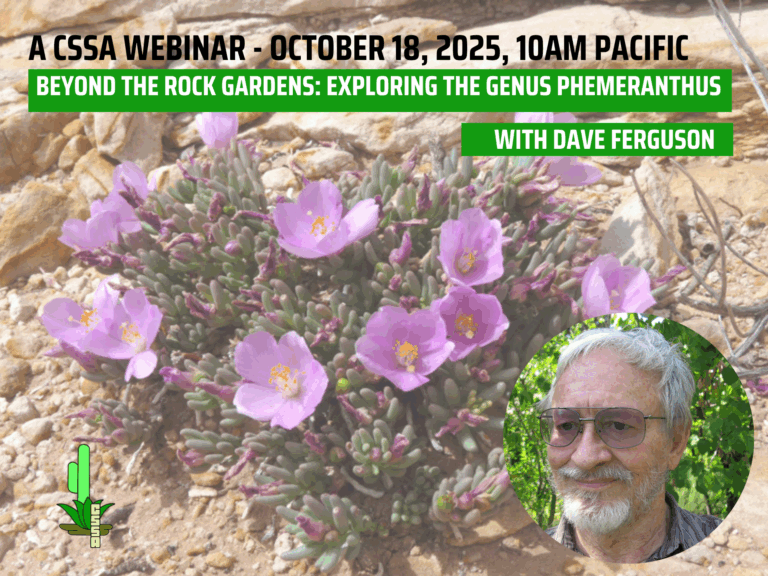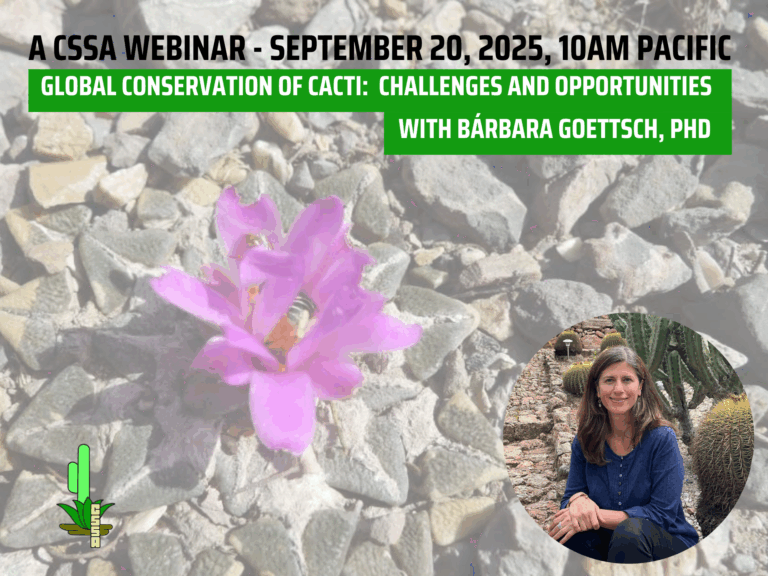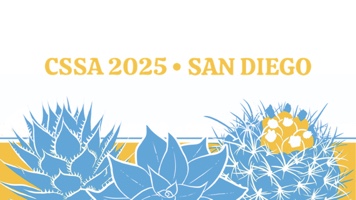The convention will feature talks from world renowned botanists, explorers, authors, and growers. It’s a great place to catch up on the latest research and make connections with these top-tier succulentists.
The San Diego Cactus & Succulent Society, has done an excellent job of finding some of the world’s preeminent cacti and succulent scientists (succulentists) to speak during the convention. These programs are sure to be a memorable experience for all attendees.
Keynote Speaker
Steven Hammer
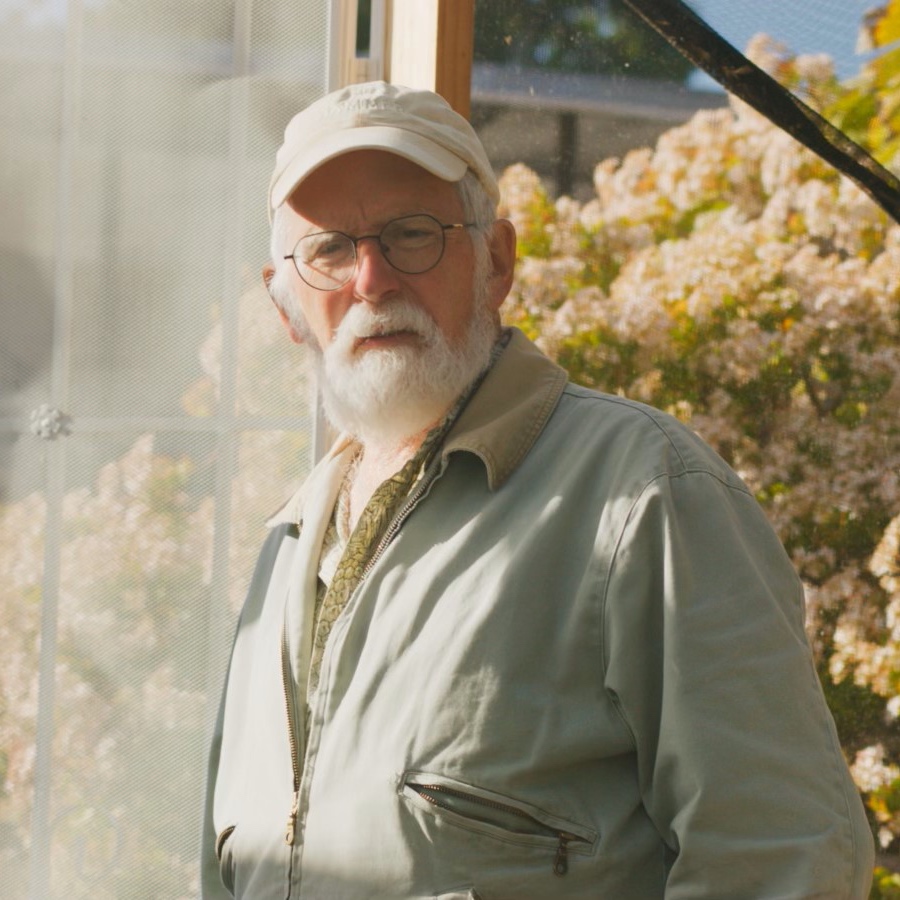
Sponsored by Colorado Cactus & Succulent Society and Central Arizona Cactus & Succulent Society
Steven Hammer’s fascination with plants began early, rooted in the semi-rural landscape of the San Fernando Valley, where his family moved when he was a baby. His passion for succulents took off at age 12 after a visit to Johnson’s Cactus Gardens in California. There, his love for lithops and other mesembs was ignited, setting him on a lifelong path of plant discovery and cultivation.
After earning a Bachelor of Arts from the University of California, Santa Cruz, in 1973, Steven worked as a cactus and succulent propagator and began exploring succulents in their native habitats. His first field trip to South Africa in 1980, followed by many subsequent trips, led him to discover and describe numerous taxa, including Conophytum achabense, C. hammeri, Lithops hermetica, and Hammeria gracilis. His expertise on mesembs and other succulents has earned him recognition as a prolific researcher and author.
Steven has contributed extensively to journals like the Cactus and Succulent Journal, Haseltonia, and Bradleya. He is also the author of Conophytum: A Conograph and Dumpling and His Wife: New Views on the Genus Conophytum. His work Lithops, Treasures of the Veld has been translated into multiple languages.
His career is highlighted by numerous awards and fellowships, including honors from the Cactus and Succulent Society of America, Inc. and various botanical institutions.
International Presenters
Julia Etter & Martin Kristen – Mexico
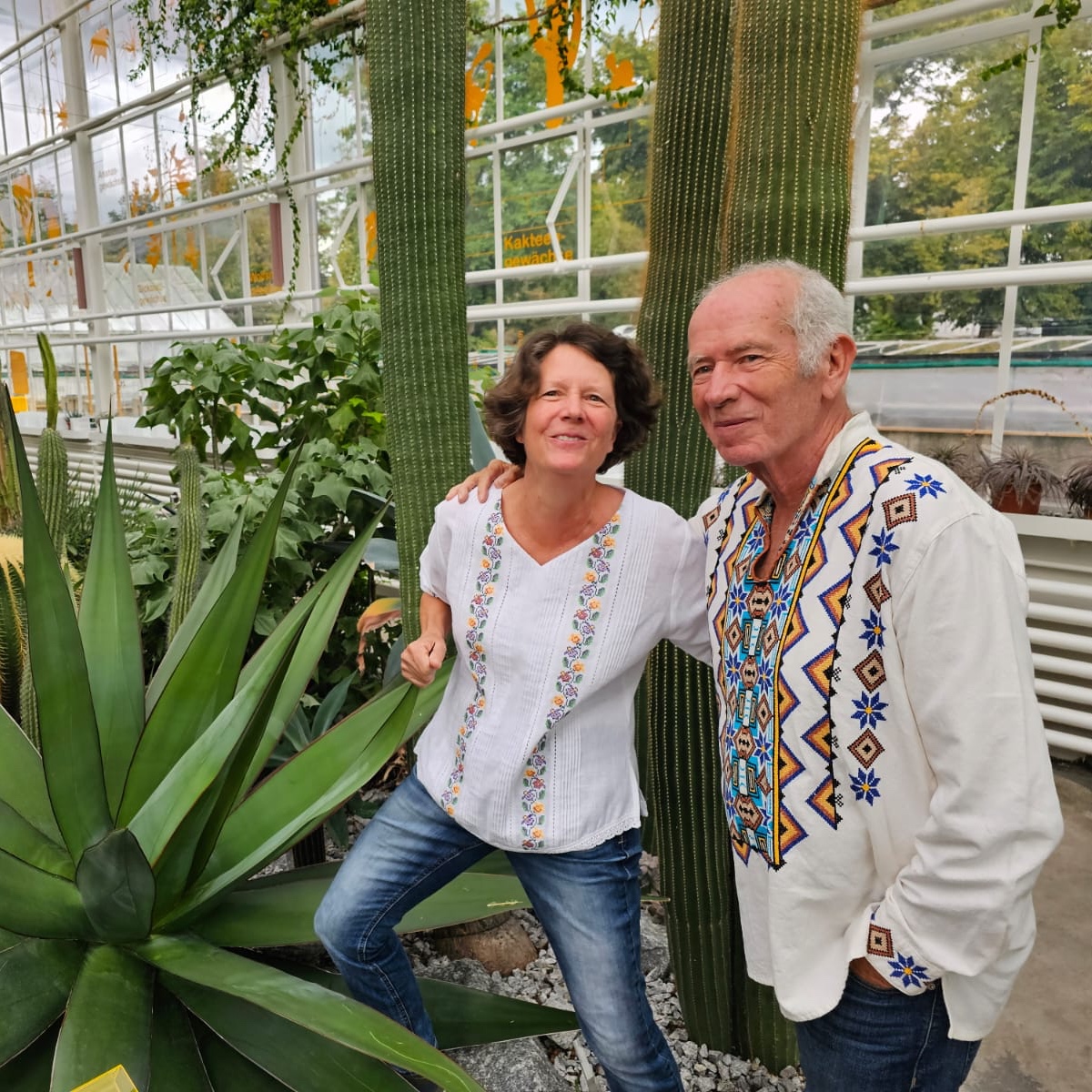
Sponsored by Rod Haenni and Cactus & Succulent Society of New Mexico
Hailing from Switzerland and Austria, Julia Etter and Martin Kristen have dedicated their lives to the study of Agavaceae and Crassulaceae since 1989. Their passion for these plant families led them into the field in 1997, where they embarked on extensive research. For several years, they roamed the deserts of the southwestern United States and Mexico in their Unimog expedition vehicle, “PocoLoco,” capturing stunning photographs and studying the unique flora of these regions.
Nearly 20 years ago, Julia and Martin made Jalisco, Mexico, their home, embracing the local culture and lifestyle. Now practically Mexican, they immerse themselves in tending their expansive garden and greenhouse, designing a botanical garden for a major Tequila factory, and caring for a lively menagerie of chickens and seven cats. Despite their busy lives, they still seize every opportunity to explore the field.Since 2009, Julia and Martin have collaborated with botanists from the Institute of Biology at UNAM and the University of Guadalajara. Their contributions to botany have been honored with several plant species named after them, including Agave kristenii, Echeveria juliana, E. kristenii, Graptopetalum kristenii, and Sedum kristenii. Their work has been widely published in books, journals, and online, reflecting their deep commitment to sharing the beauty and knowledge of these remarkable plants. More information about their work can be found at agavaceae.com and crassulaceae.com.
Attila Kapitany – Australia

Sponsored by San Diego Cactus & Succulent Society
Attila Kapitany is a leading expert on Australian succulents. He has written and co-authored 18 books or publications on cacti and succulents including large tomes on Copiapoa and Echeveria.
Over 45 years ago, with his brother Jeno, they developed and established several nurseries, both wholesale and retail, that are now Australia’s largest centres for succulent research, development and marketing.
Attila often works with botanists to research and write publications about unusual and rare Australia desert flora. Attila and his wife Michele also have a one acre botanical garden (aside from the house and garden where they live.) The most unique component of this garden is the successful trials incorporating Australian native species to show the public and the horticultural industry what can be achieved. He has regularly appeared on television, radio and stages around the country and internationally. His website is also dedicated to increasing the awareness, appreciation, conservation and cultivation of Australian native succulent flora: www.australiansucculents.com.
In the last 20 years he has become best known for his work with Australian native succulents and other xerophytes including bottle trees, grass trees and cycads. Along with the Australian Government, Attila helped organise a series of postage stamps featuring his favourite plants.
At the convention Attila will be showing many images of new and rare plants that many attendees will have never seen before!
Andry Petignat – Madagascar

Sponsored by Phuc Huynh
Andry Petignat has dedicated his life to protecting the unique flora of Madagascar’s spiny forest and raising awareness about the urgent need to conserve this increasingly fragmented region. Born and educated in Toliara, southwestern Madagascar, Andry inherited a deep connection to the local environment from his father, who founded the Antsokay Arboretum in the early 1980s. Since 2003, Andry has continued his father’s legacy by managing the arboretum, which houses over 900 plant species, 90 percent of which are endemic to the spiny forests of southwest Madagascar. The arboretum plays a crucial role in the conservation of these endangered species.
With support from the Critical Ecosystem Partnership Fund, Andry has spearheaded several educational initiatives at the arboretum. These include the creation of an education center, the development of activities for school children and teachers, and the recruitment of local educators to raise awareness about the importance of plant diversity and sustainable natural resource management.
Currently, the arboretum is leading a project aimed at protecting and restoring a critical protected area in the Toliara region, furthering its mission to conserve Madagascar’s unique biodiversity.
Andry is also a co-author of several notable works, including Baobabs of the World, Guide to the Succulent Plants of Southwest Madagascar, and Baobabs de Madagascar.
Elisabeth & Norbert Sarnes – Germany
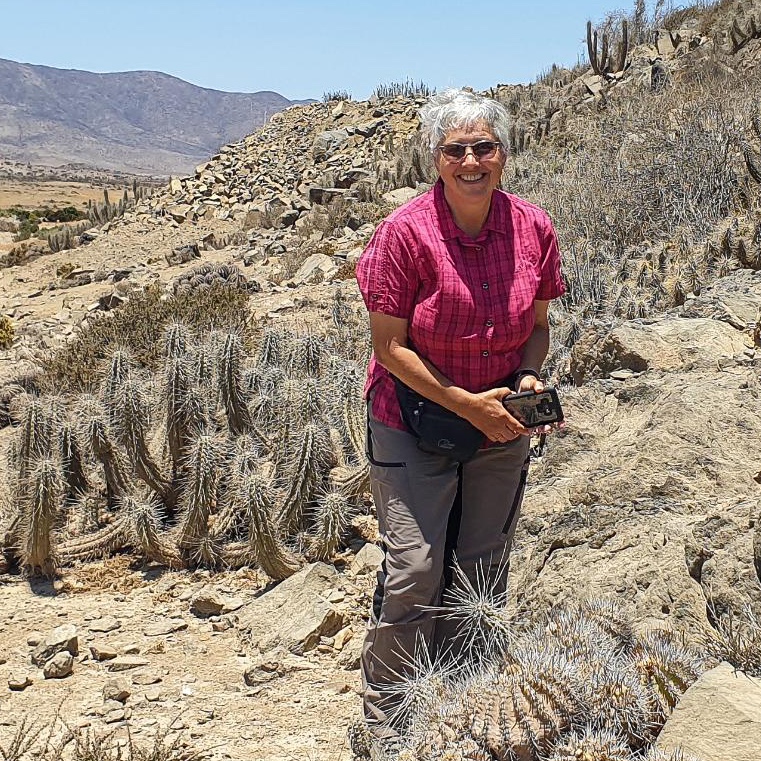
Sponsored by South Coast Cactus & Succulent Society
Elisabeth and Norbert Sarnes, a passionate German couple, began their journey into the world of cacti in 1977. However, it wasn’t until a transformative trip to Patagonia in 2004 that they decided to focus on specific genera: Austrocactus and Pterocactus in Argentina, Copiapoa and Eriosyce in Chile, and Maihueniopsis in both countries. This initial expedition sparked a deep fascination that led them on numerous travels across South America, primarily in Argentina and Chile, where they spent more than two years collectively in search of cacti.
Their extensive fieldwork and studies have resulted in several published articles in both German and international journals, including the first descriptions of new Austrocactus species and a Pterocactus. Their dedication to the field also led to the publication of their books, Cactus de Patagonia in 2012, Austrocactus 2015, and a booklet on the genus Pterocactus in 2021.
At their home in western Germany, Elisabeth and Norbert cultivate a diverse collection of seed-grown cacti, covering about 50 square meters. Both are active members of the German Cactus Association (DKG), British Cactus & Succulent Society (BCSS), Cactus & Succulent Society of America, Inc. (CSSA), Succulenta, and IOS. Norbert served as Vice-President of the DKG from 2008 to 2017, while Elisabeth plays a key role in organizing the ELK, Europe’s largest cactus event. Over the past decade, they have had the honor of speaking at numerous cactus events and meetings worldwide, sharing their expertise and passion with the global cactus community.
Pieter Van Wyk – South Africa
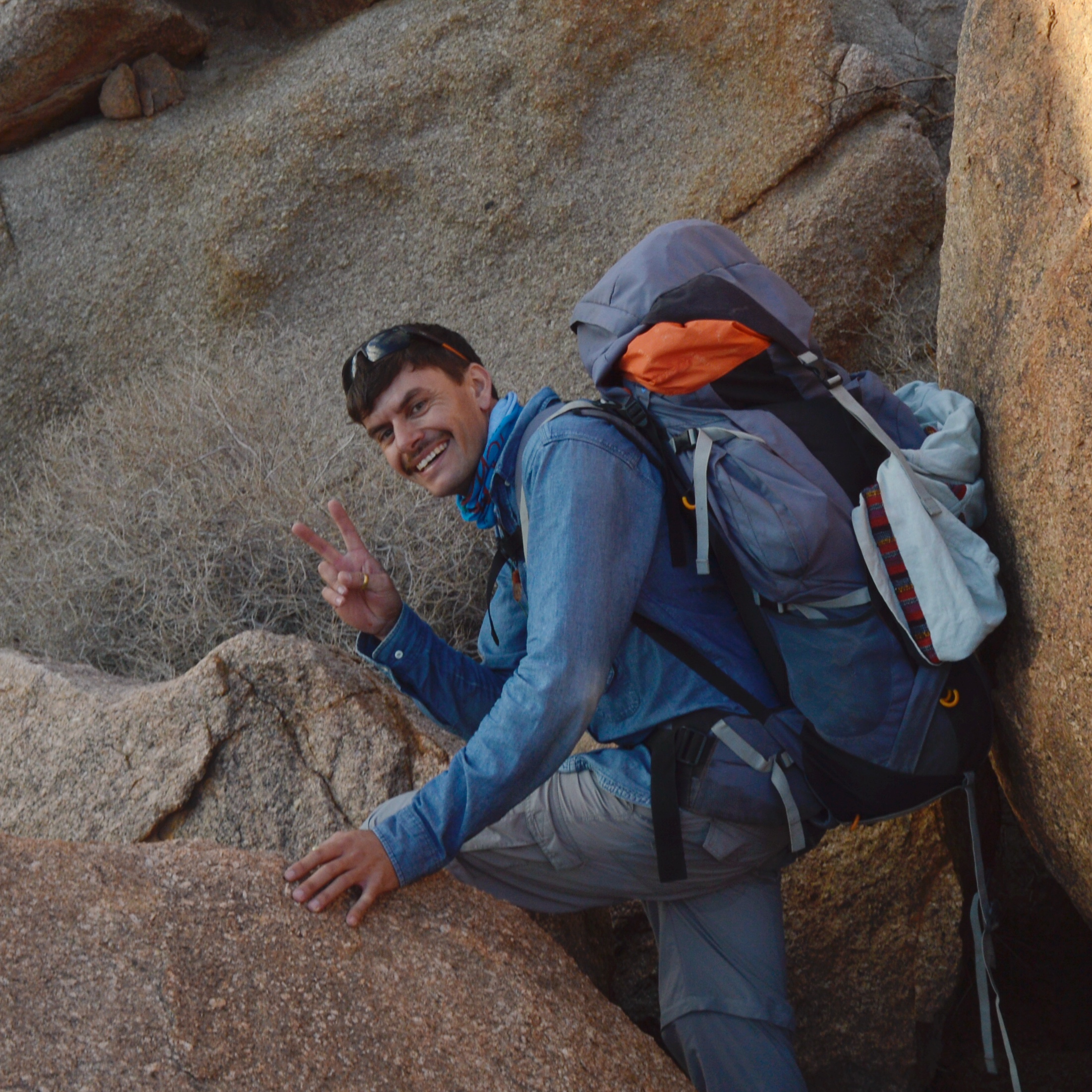
Sponsored by San Francisco Succulent and Cactus Society, Sunset Succulent Society, Mid Iowa Cactus & Succulent Society, and River City Cactus & Succulent Society
Pieter Van Wyk was born in the Richtersveld, a region within the Gariep Centre of Endemism, renowned as the most succulent-rich desert in the world. From a young age, Pieter was immersed in the traditional knowledge of the Richtersveld’s indigenous flora, learning about their medicinal, edible, and household uses. By the age of 14, he began a deep and focused study of the region’s plant life, which has since evolved into a 22-year journey dedicated to documenting the Richtersveld’s unique flora.
Pieter is currently working on an extensive book detailing the region’s flora, covering 1,700 species, alongside publishing numerous taxonomic and ecological scientific papers. Since 2014, he has been involved with the South African National Biodiversity Institute’s Red List program and the IUCN Red List, revising all endemic and near-endemic species of the Gariep Centre of Endemism.
Employed full-time by South African National Parks, Pieter is the curator and founder of the Richtersveld Desert Botanical Garden—the newest botanical garden in South Africa and the only one located within the desert biome and a national park. His work has led to the discovery of several new species in the Richtersveld, which he is in the process of describing. Additionally, he is conducting a taxonomic revision of the genus Astridia, studying the plant community structures of the Gariep high mountains, and performing fine-scale mapping of quartz field plant communities throughout the Richtersveld.
Pieter’s life mission is to ensure the conservation of the Gariep Centre of Endemism, a region facing significant ecological threats.
US Presenters
Michelle Cloud-Hughes
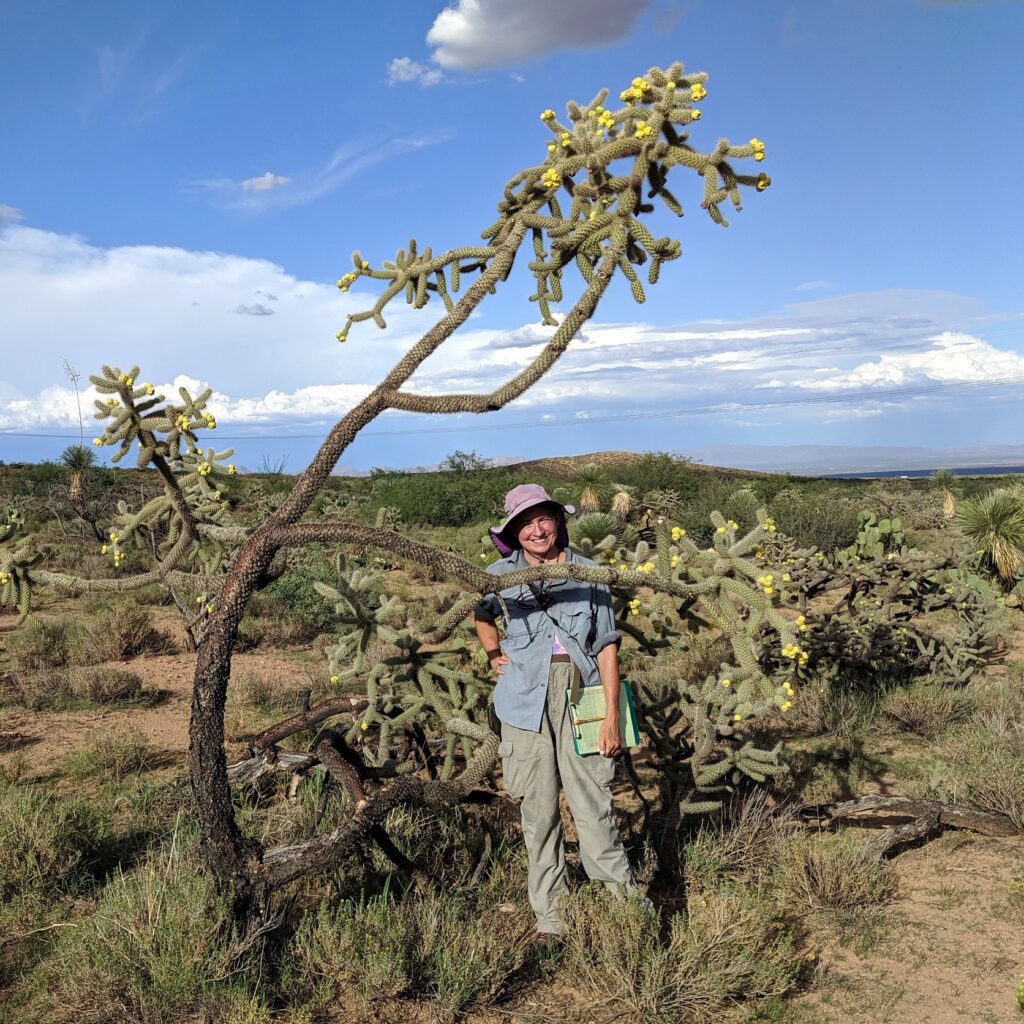
Sponsored by Central Arizona Cactus & Succulent Society
Michelle Cloud-Hughes is a seasoned botanist and restoration ecologist with a deep passion for the desert flora and ecosystems of North America. With over 17 years of experience at the Soil Ecology and Restoration Group at San Diego State University, Michelle transitioned into entrepreneurship in 2010 by founding Desert Solitaire Botany and Ecological Restoration. Since then, she has become a leading expert in rare plant surveys and has spearheaded numerous botanical and ecological restoration projects across the southwestern United States and Mexico.
Michelle is a recognized authority on the genus Cylindropuntia (chollas) and played a pivotal role in the discovery and description of Cylindropuntia chuckwallensis, a rare species endemic to California and the newest addition to the state’s cactus flora. Her research is primarily focused on unraveling the evolutionary relationships within the cholla tribe, though she occasionally explores other fascinating cactus genera, including Pediocactus and Echinocereus. Michelle’s work is not just about plants; it’s about preserving and understanding the delicate balance of life in some of the world’s most arid landscapes.
Kelly Griffin
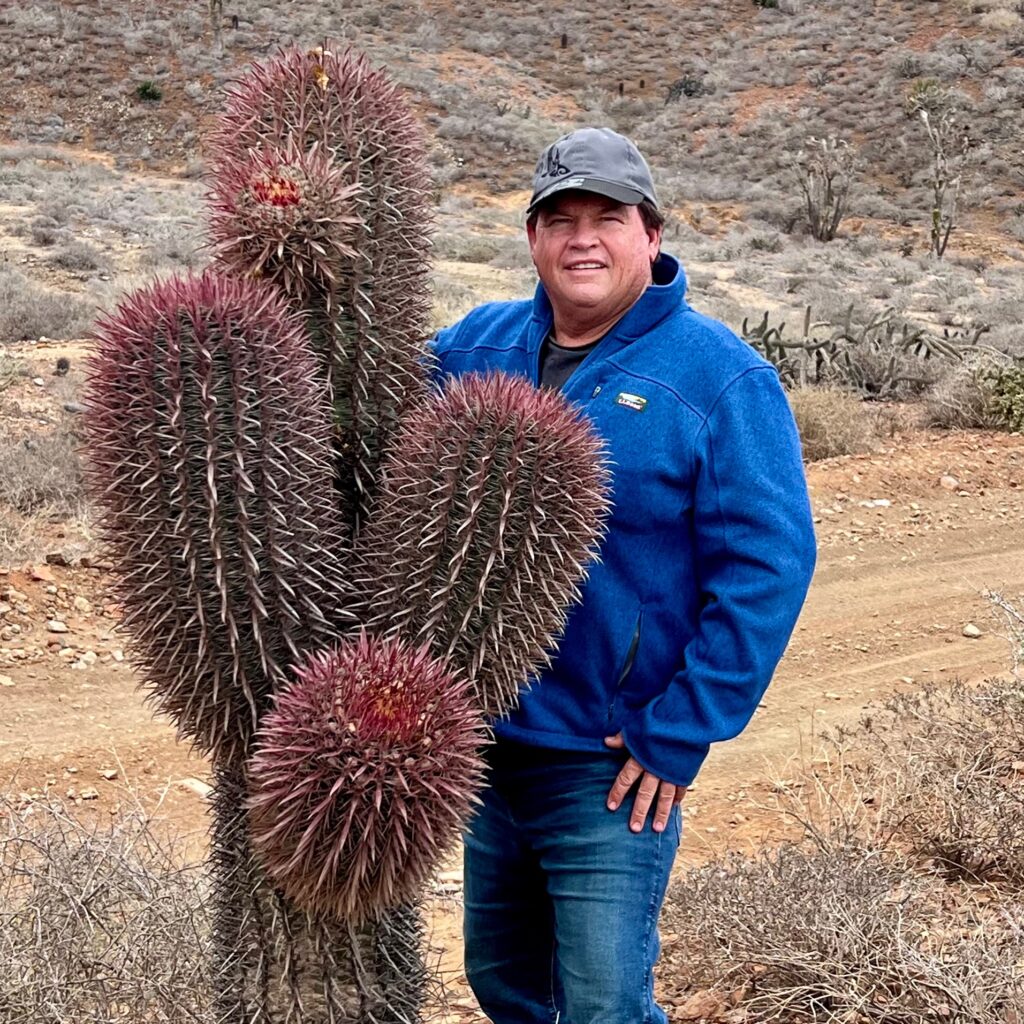
Sponsored by Fairview Nursery
Kelly Griffin is a plant hybridizer for Altman Specialty Plants located in Vista, CA. While he has a penchant for finding and photographing succulent plant habitats in general, he has had a great interest in the mostly California genus of Dudleya. Looking for Dudleyas in the field has been a constant passion for him going on four decades. He is always striving to get that next great photo. Kelly is also a board member of CSSA and the San Diego Cactus & Succulent Society, in addition to the Chair of the Convention Committee.
Brian Kemble
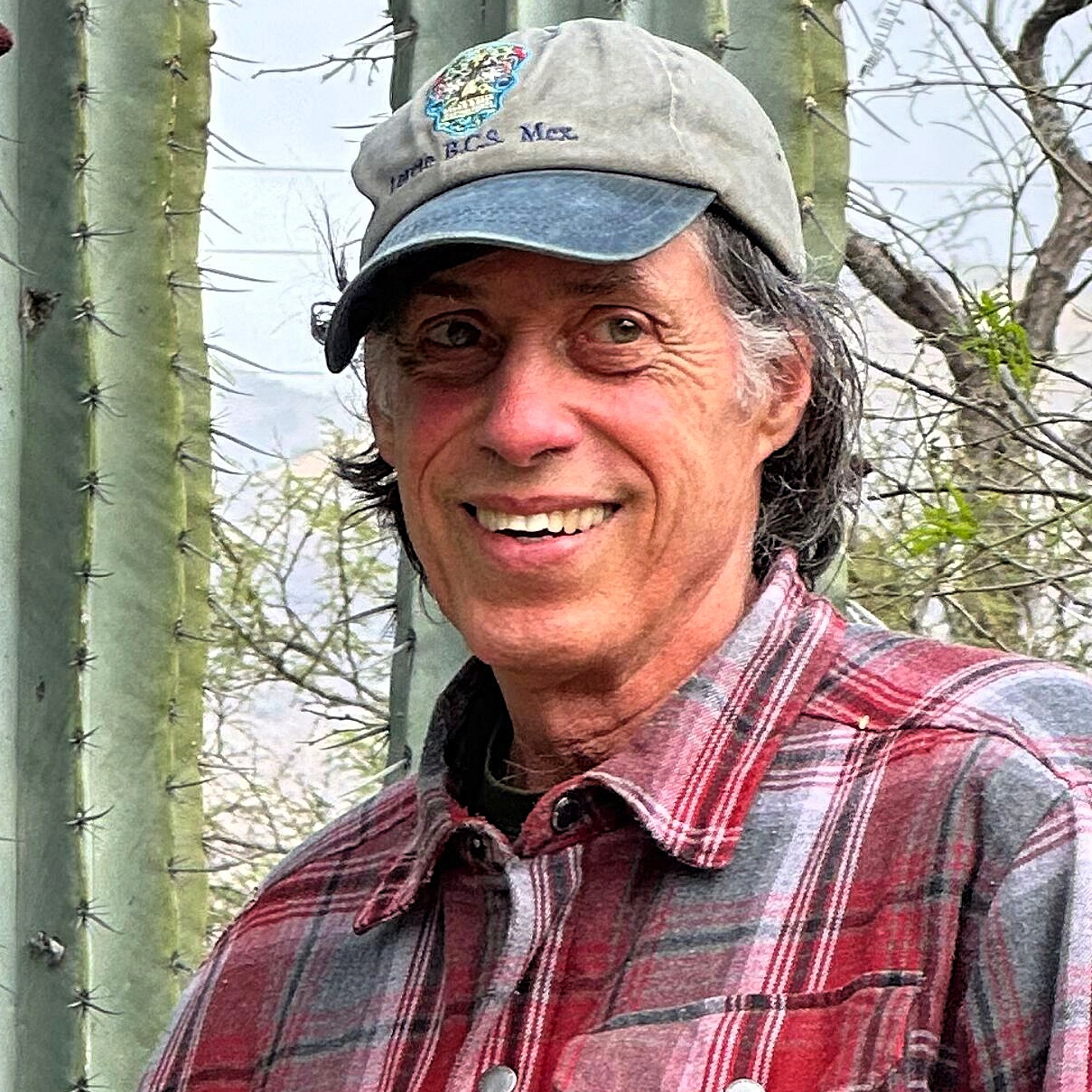
Sponsored by Bill Wilk and Cactus & Succulent Society of San Jose
Brian Kemble is the Curator at the Ruth Bancroft Garden & Nursery in Walnut Creek, California, where he has been a cornerstone of the garden’s development since 1980. Under his stewardship, the Ruth Bancroft Garden was recently honored as “The Most Beautiful Garden in the World” by Tripadvisor. In addition to his curatorial work, Brian serves as Vice President of the San Francisco Succulent & Cactus Society and is a former board member of the Cactus & Succulent Society of America, Inc.
Brian’s passion for succulent plants has taken him on extensive travels to their native habitats around the globe. He has authored hundreds of articles and contributed his photography to numerous books, including the Timber Press Guide to Succulent Plants of the World. Among his many botanical interests, aloes hold a special place, leading him to explore them in their natural environments across South Africa, Namibia, Lesotho, Madagascar, and Ethiopia. Brian was recently honored with the prestigious Liberty Hyde Bailey Award, by the American Horticultural Society, for his lifetime contributions to horticulture.
Tom Knapik

Sponsored by Austin Cactus & Succulent Society
Originally from northern New York, Tom Knapik made his way to California in 1976, beginning his college journey at the University of San Diego before transferring to Humboldt State University. He graduated in 1981 with a degree in Biology and Zoology. A year later, a visit to a college friend introduced Tom to a small succulent collection—an encounter that would spark a lifelong passion and shift the course of his life.
Tom returned to San Diego in 1984, where he launched his teaching career and began working part-time at David Grigsby’s cactus nursery. He joined the San Diego Cactus and Succulent Society (SDCSS), where his involvement grew over the years—serving as program chair, board member, president, newsletter editor, and annual show chair for 12 years. It was at one of these shows that he met his future wife, Carol.
Tom’s love for succulent plants has taken him across the globe. He has photographed collections in England, Italy, the Czech Republic, Austria, Thailand, the Philippines, Japan, Australia, and New Zealand. He’s also explored succulents in their natural habitats in Mexico, Peru, Chile, Brazil, Bolivia, Venezuela, South Africa, Namibia, and the U.S.
Tom McCoy

Sponsored by Henry Shaw Cactus Society
Tom McCoy, born in Long Beach, California, developed a deep passion for natural history from a young age, collecting fossils, seashells, reptiles, birds, and plants. His love for botany led him to travel extensively across Asia, Africa, the Americas, Arabia, and Madagascar. For over 30 years, McCoy has lived in Saudi Arabia, balancing his career with a focus on the genus Aloe. He has published extensively on the subject, naming over 50 species, and maintains one of the world’s largest documented live collections of Aloe. McCoy is also an accomplished aviculturist and bibliophile. He is a Fellow of the Linnean Society of London and holds memberships in numerous scientific organizations, including the American Society of Plant Taxonomists and the Botanical Society of America.
Guillermo Rivera
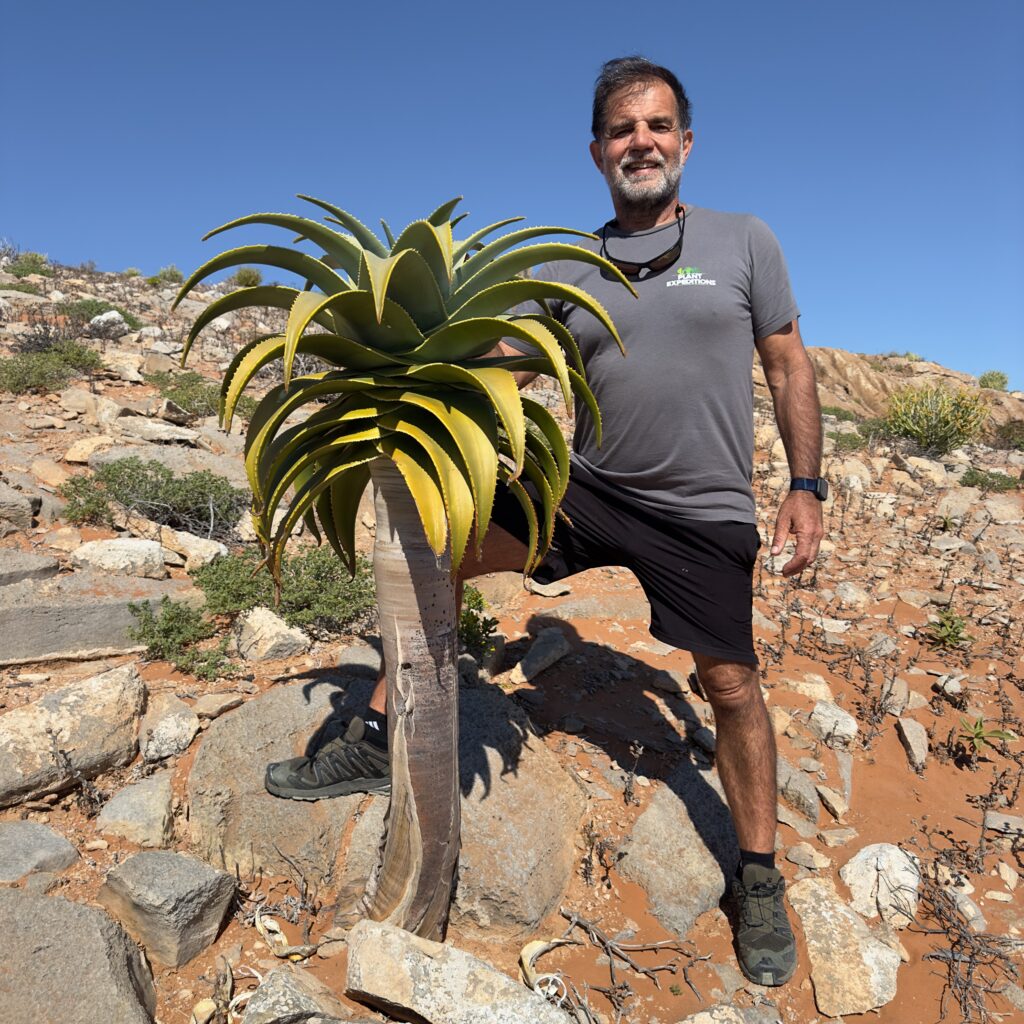
Sponsored by Gates Cactus & Succulent Society and Pacific Sun Ceramics & Succulents
Born and raised in Argentina, Guillermo Rivera is the adventurous spirit behind PLANT EXPEDITIONS (formerly South America Nature Tours), a company that has been leading botanical journeys across the globe for over 24 years. Guillermo’s expeditions are a gateway to some of the most breathtaking and biodiverse regions on Earth, including South America (Chile, Argentina, Brazil, Peru, Colombia, Bolivia, Ecuador), Mexico, South Africa, Madagascar, Socotra, and Namibia. His tours are a deep dive into the world of plants, with a special focus on bromeliads, orchids, cacti, and other succulents.
Guillermo’s passion for the natural world is rooted in a rich academic background. He holds a BS in Biology and a PhD in Botany from the University of Cordoba, Argentina, and an MS in Marine Biology from Northeastern University. Before embarking on his global adventures, Guillermo was a dedicated researcher at the University of Cordoba, where he honed his expertise in botany and ecology. Today, he combines his scientific knowledge with his love for exploration, offering unique travel experiences that blend education, adventure, and an appreciation for the planet’s diverse plant life.
Jeremy Spath

Sponsored by Tucson Cactus & Succulent Society
Driven by a passion for discovering exceptional, rare, and new agave species, Jeremy Spath has spent the past 20 years exploring the natural habitats of agaves across the Americas. His journey began with a deep fascination for seeing these remarkable plants in their native environments, inspiring countless expeditions to uncover the beauty of agave habitats. His expertise extends to cultivating these plants, with a particular focus on selecting and growing exceptional clones.
Jeremy’s career took root at the San Diego Botanic Garden before he transitioned to Rancho Soledad Nursery in Rancho Santa Fe, California. There, he specialized in hybridizing agaves, creating new and stunning plants for the nursery. Today, Jeremy owns and operates Hidden Agave, his own nursery in Escondido, California, where he continues his work in growing, hybridizing, and tissue culturing agaves. His passion for these plants drives him to constantly seek out the diverse and captivating habitats where they thrive.
Jeremy is also an accomplished author, recently publishing the second edition of his book Agaves: Species, Cultivars, & Hybrids, co-authored with Jeff Moore of Solana Succulents. This comprehensive 350+ page book delves into the world of agaves, both in cultivation and in their natural habitats, featuring over 1,500 images and in-depth information on various species, cultivars, and hybrids, including many newly discovered ones. The book is available on his website, hiddenagave.com.
Joe Stead

Sponsored by Dick Wiedhopf
Joe Stead is a dedicated Horticulture Coordinator and part-time instructor at Orange Coast College in Costa Mesa, CA, where he has been shaping the college’s horticulture program for over 25 years. With a deep passion for plant propagation and hybridization, Joe has become a respected expert in his field. His work has been featured in several co-authored articles in the Cactus and Succulent Journal, focusing on species such as Boswellia, Operculicarya, and Fouquieria. One of his succulent garden designs was also highlighted in Sunset Magazine.
Currently, Joe is spearheading two major projects: the planning and installation of a large succulent garden around the planetarium on the Orange Coast College campus, and a new International Succulent Introductions (ISI) project for the Huntington Botanical Gardens.
Joe resides in Tustin, CA, with his wife, Liann.
Final speakers are subject to change.
